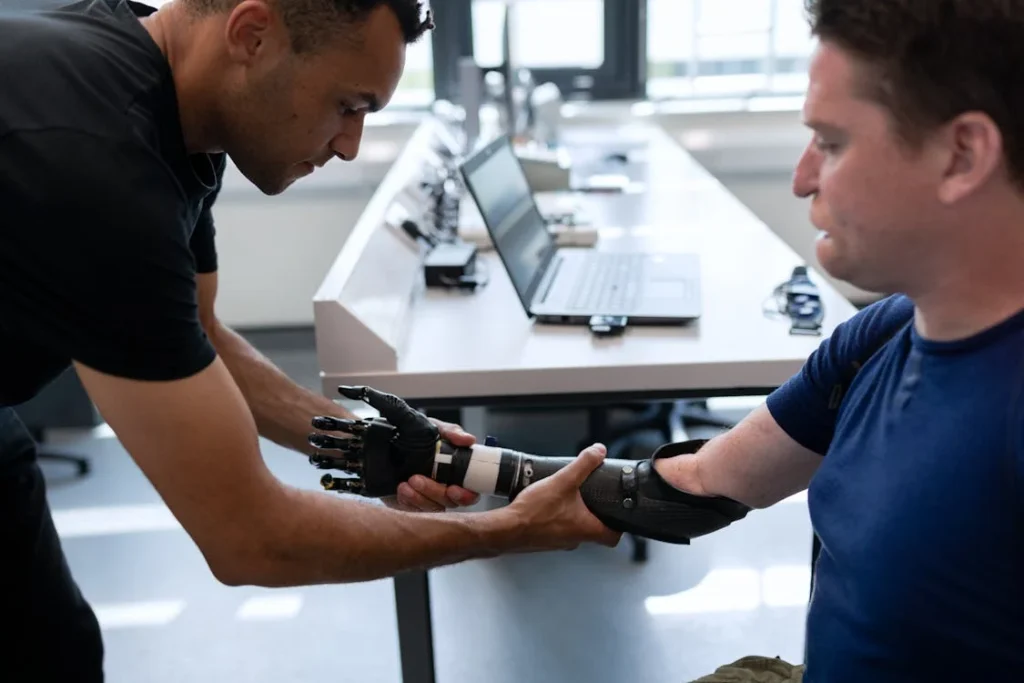Recovery after an amputation is a complex process that involves both physical and emotional adjustments. Swelling and pain are natural parts of this journey, but they can feel overwhelming without the right strategies to manage them. These symptoms often arise as your body heals and adapts, and understanding how to address them effectively can make a significant difference in your recovery experience.
Managing swelling and pain requires a combination of medical guidance, self-care techniques, and patience. With the right approach, you can reduce discomfort, promote healing, and regain control over your recovery. In this article, we’ll explore practical ways to manage swelling and pain during amputation recovery, empowering you to feel more comfortable and confident as you heal.
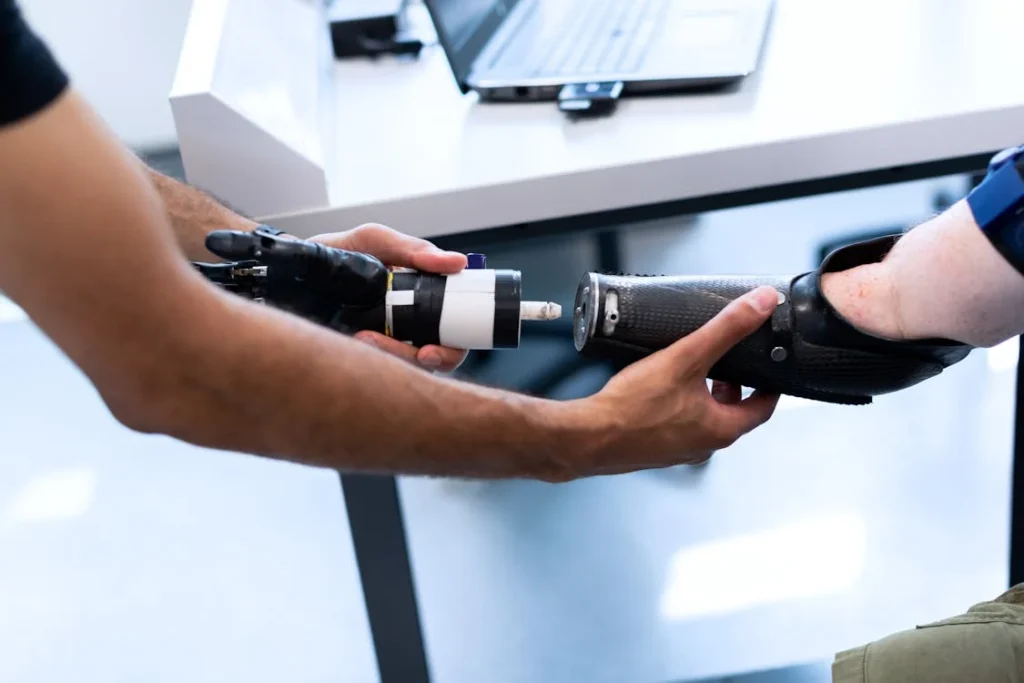
Understanding Swelling and Pain During Amputation Recovery
Swelling and pain are natural responses to surgery, including amputation. These symptoms occur as part of your body’s healing process, which involves repairing tissues, managing inflammation, and adapting to changes in blood flow and nerve activity.
While these sensations are common, they can vary widely depending on factors like the level of amputation, overall health, and how well your recovery is managed.
Why Swelling Happens
Swelling, or edema, after an amputation is a normal reaction to surgical trauma. During the healing process, your body sends blood and fluid to the surgical site to support tissue repair.
This increased circulation is essential for recovery, but it can also lead to puffiness or tightness in the residual limb. Swelling may feel uncomfortable or restrictive, especially when preparing to use a prosthetic device.
Swelling can also be influenced by external factors like prolonged inactivity, poor positioning of the limb, or inadequate compression therapy.
If left unmanaged, excessive swelling can delay healing, make it harder to fit a prosthetic limb, or contribute to complications like infections or pressure sores.
The Nature of Post-Amputation Pain
Pain during recovery can arise from several sources, including the surgical incision, changes in nerve activity, and the body’s overall response to surgery.
Acute pain, which is sharp and temporary, typically occurs as the surgical site heals. This pain diminishes over time as the tissues recover and inflammation subsides.
Another type of pain that many amputees experience is phantom limb pain. This occurs when the brain continues to receive signals from nerves that previously controlled the missing limb.
Phantom pain can feel like burning, tingling, or cramping and may be triggered by stress, weather changes, or certain movements.
Residual limb pain, distinct from phantom limb pain, originates from the remaining part of the limb. It can be caused by irritation, scar tissue, or sensitivity in the surgical area. Proper care of the residual limb is crucial in minimizing this type of pain.
The Importance of Early Intervention
Managing swelling and pain effectively during the early stages of recovery is essential for long-term success. These symptoms can interfere with physical therapy, delay prosthetic fitting, and affect your overall quality of life if not addressed.
Early intervention not only reduces discomfort but also sets the foundation for smoother rehabilitation and adaptation.
Healthcare providers often recommend a combination of strategies, including compression therapy, gentle movement, pain management techniques, and emotional support. Each approach plays a role in helping you feel more comfortable and in control during your recovery.
By understanding the causes and nature of swelling and pain, you can better equip yourself to handle these challenges. The next step is learning practical techniques and strategies to manage these symptoms, ensuring a smoother and more comfortable recovery experience.
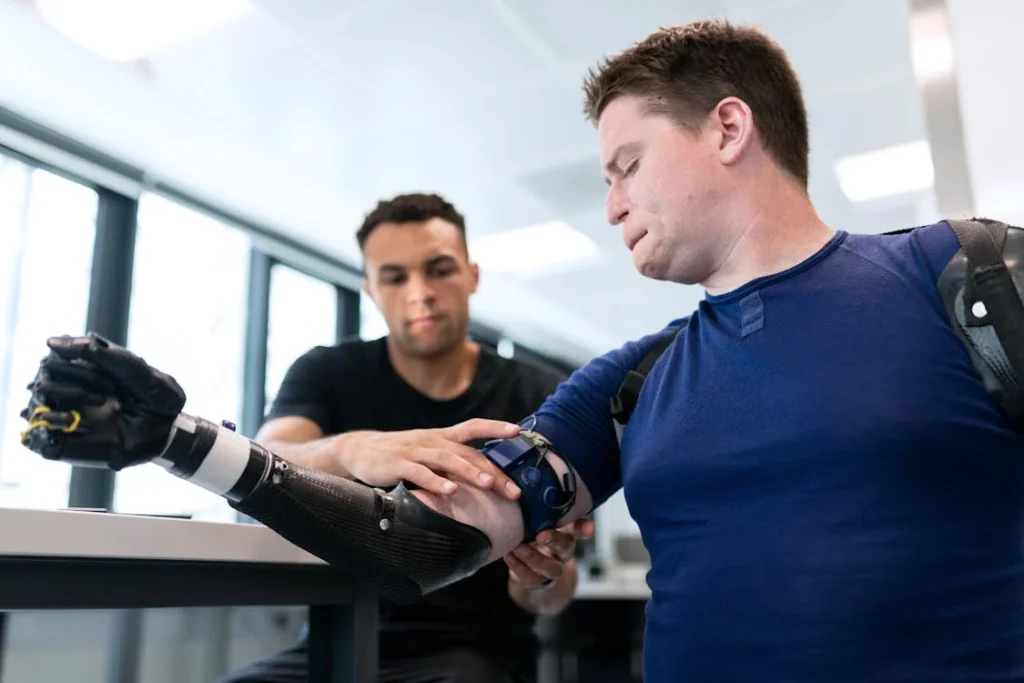
Strategies to Manage Swelling During Amputation Recovery
Effectively managing swelling, or edema, after an amputation is crucial for promoting healing, improving comfort, and preparing your residual limb for a prosthetic device.
While swelling is a natural part of the healing process, taking proactive steps can reduce its intensity and help you regain mobility faster.
Elevation and Positioning
One of the most effective ways to reduce swelling is by elevating your residual limb. Elevation helps improve circulation and prevents fluid from pooling in the limb.
Keeping your limb elevated above the level of your heart for short periods throughout the day encourages fluid drainage and minimizes discomfort.
When resting, use pillows or cushions to support your limb in a comfortable position. Avoid letting the limb hang down for extended periods, as this can increase swelling. Proper positioning also helps maintain the shape of the residual limb, which is essential for a good prosthetic fit.
Compression Therapy
Compression therapy is a key method for managing swelling after an amputation. Compression bandages or shrinker socks are often used to apply gentle pressure to the residual limb, promoting blood flow and preventing fluid buildup.
This pressure helps reduce puffiness and supports the shaping of the limb, which is critical for prosthetic readiness.
Using compression tools requires guidance from your healthcare provider or therapist. They will show you how to properly apply bandages or wear shrinker socks to ensure effective compression without causing discomfort or restricting circulation.
Regular use of compression therapy can significantly improve swelling management and accelerate recovery.
Gentle Movement and Exercise
Engaging in gentle movement and exercises can help stimulate circulation and reduce swelling.
Activities like ankle pumps, where you flex and point your toes (if applicable), or light stretches recommended by your physiotherapist, encourage blood flow and prevent fluid from accumulating in the limb.
Physical activity should be introduced gradually and tailored to your specific needs and recovery stage. Working with your healthcare team ensures that exercises are both safe and effective.
Movement not only reduces swelling but also strengthens the muscles surrounding the residual limb, supporting long-term rehabilitation.
Hydration and Diet
Staying hydrated is another essential component of swelling management. Drinking enough water helps maintain fluid balance in the body and prevents dehydration, which can worsen swelling.
Complement this by incorporating a nutrient-rich diet that supports healing and reduces inflammation.
Foods like leafy greens, berries, and fatty fish contain antioxidants and anti-inflammatory properties that can help manage swelling. Reducing salt intake may also be beneficial, as excess sodium can contribute to fluid retention.
A balanced diet provides your body with the resources it needs to heal effectively.
Consistency Is Key
Managing swelling requires consistent effort and a proactive approach. Establishing a routine that includes elevation, compression therapy, and gentle movement helps create an environment where your body can heal efficiently.
Regular follow-ups with your healthcare provider allow for adjustments to your treatment plan and ensure that you’re making progress.
By actively managing swelling, you set the stage for a smoother recovery and prepare your residual limb for the next steps in rehabilitation. Swelling control not only improves physical comfort but also boosts your confidence and readiness for life with a prosthetic device.
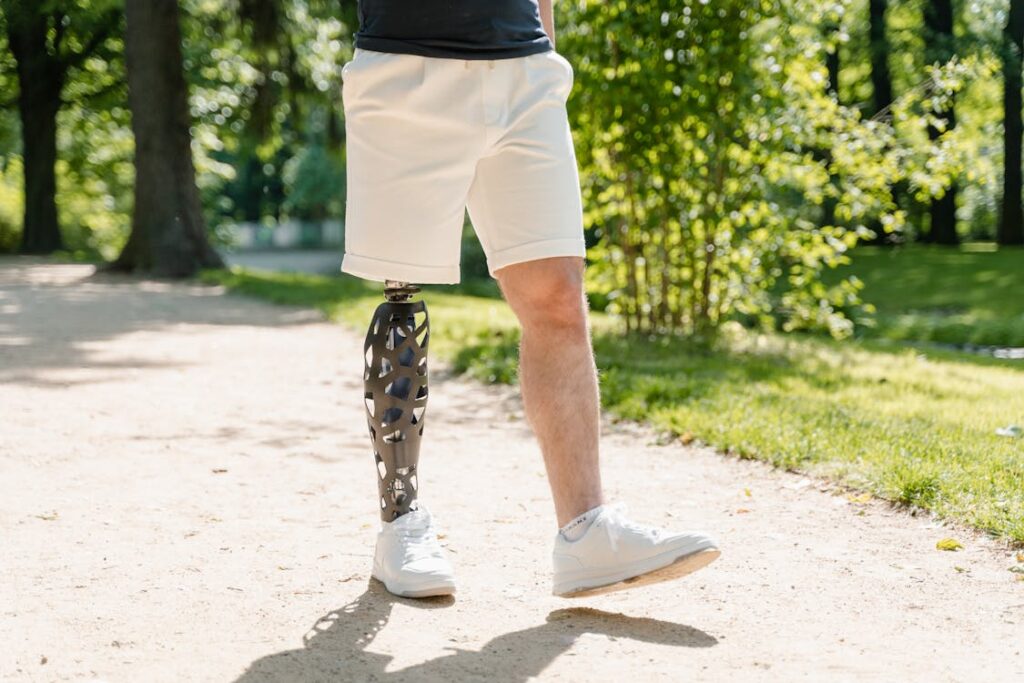
Strategies to Manage Pain During Amputation Recovery
Pain management is a critical aspect of amputation recovery. Pain can be both physical and emotional, and finding effective ways to address it is essential for healing, rehabilitation, and overall quality of life.
Understanding the sources of pain and using a combination of approaches can help you regain comfort and focus on recovery.
Following Your Pain Management Plan
After your surgery, your healthcare provider will develop a personalized pain management plan tailored to your needs. This plan may include medications, therapies, and lifestyle adjustments designed to address both acute and chronic pain.
It’s important to follow this plan closely and communicate with your healthcare team about what works and what doesn’t.
Medications such as over-the-counter pain relievers, prescription drugs, or nerve-specific medications may be recommended to control pain.
Using these medications as directed helps prevent discomfort from interfering with your recovery progress. Always discuss any side effects or concerns with your doctor to ensure safe and effective use.
Caring for the Residual Limb
Proper care of your residual limb can significantly reduce pain. Keeping the limb clean and dry prevents irritation and infection, which can exacerbate discomfort.
Following your doctor’s instructions for wound care, dressing changes, and hygiene ensures that the limb heals without complications.
Massaging the residual limb, as recommended by your therapist, can also help reduce sensitivity and improve circulation. Gentle massages may prevent the formation of scar tissue and desensitize the area, making it more comfortable to wear a prosthetic device in the future.
Addressing Phantom Limb Pain
Phantom limb pain, a sensation of discomfort in the missing limb, is a common experience for many amputees. While the exact cause isn’t fully understood, it’s believed to result from the brain and nerves continuing to send signals to the lost limb.
This pain can feel real and distressing, but it’s manageable with the right techniques.
Mirror therapy is one effective method for addressing phantom limb pain. By using a mirror to create the illusion of the missing limb, your brain can be “tricked” into perceiving movement in the absent limb, which often reduces pain.
This technique is simple yet powerful and is frequently included in rehabilitation programs.
Relaxation techniques, such as deep breathing and mindfulness meditation, can also help manage phantom pain. These approaches teach you to focus on your body’s sensations without becoming overwhelmed by them.
Over time, these practices may reduce the intensity and frequency of phantom limb sensations.
Physical Therapy and Movement
Engaging in physical therapy not only supports your mobility but also helps manage pain. Exercises designed to strengthen muscles, improve circulation, and restore balance can reduce discomfort in the residual limb and surrounding areas.
Movement promotes the release of endorphins, your body’s natural painkillers, which can help ease both physical and emotional pain.
A physiotherapist will guide you through safe and effective exercises tailored to your stage of recovery. This partnership ensures that your activities are beneficial and align with your overall rehabilitation goals.
Emotional and Psychological Support
Pain isn’t just a physical experience—it’s closely tied to your emotional state. Stress, anxiety, or feelings of frustration can amplify your perception of pain, making it harder to manage.
Addressing the emotional aspects of recovery is as important as treating the physical symptoms.
Talking to a counselor or therapist can provide a safe space to explore your feelings and develop coping strategies. Support groups, where you connect with others who have experienced limb loss, can also offer emotional relief and practical advice for managing pain.
Knowing you’re not alone in your journey can make a significant difference in your outlook and resilience.
Long-Term Pain Management
For some individuals, pain may persist beyond the initial recovery period. Long-term pain management focuses on combining treatments and techniques to maintain comfort and quality of life.
This may include ongoing physical therapy, adjustments to your prosthetic device, or exploring alternative therapies like acupuncture or transcutaneous electrical nerve stimulation (TENS).
Pain management is a dynamic process that requires patience, communication, and a willingness to try different approaches.
By working closely with your healthcare team and staying proactive in your care, you can find strategies that help you regain control and move forward with confidence.
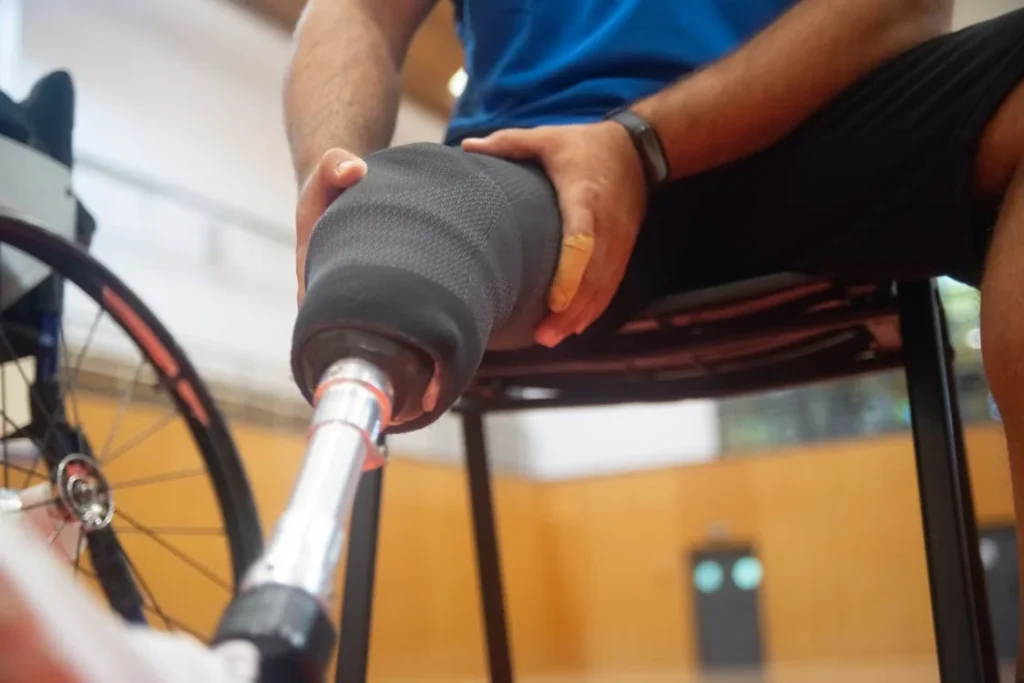
Combining Swelling and Pain Management with Rehabilitation
Swelling and pain management are deeply intertwined with the process of rehabilitation. Addressing these issues effectively not only promotes healing but also enhances your ability to engage in therapy and adapt to life with a prosthetic limb.
Incorporating pain and swelling management strategies into your rehabilitation program ensures a smoother transition toward mobility and independence.
The Role of Compression Therapy in Rehabilitation
Compression therapy, commonly used to manage swelling, plays a dual role in rehabilitation. Beyond reducing edema, compression garments or bandages help shape the residual limb, ensuring it maintains a form suitable for prosthetic fitting.
Proper shaping is crucial for both comfort and function when using a prosthetic device.
During rehabilitation sessions, therapists often combine compression techniques with exercises designed to improve circulation and flexibility.
This integrated approach minimizes discomfort, prepares your limb for weight-bearing activities, and helps you progress toward your mobility goals.
Physical Therapy for Pain Relief
Physical therapy is a cornerstone of recovery after an amputation, and it can also be an effective way to manage pain. Guided exercises strengthen the muscles around your residual limb, improving stability and reducing strain on surrounding joints.
Therapists may also use techniques like massage, stretching, or heat and cold therapy to alleviate pain and stiffness.
Engaging in low-impact activities, such as seated exercises or hydrotherapy, can provide relief while promoting overall fitness. Movement stimulates the release of endorphins, which are natural pain relievers that also improve mood.
Regular physical therapy sessions allow you to address both your physical and emotional well-being, creating a comprehensive recovery experience.
Adapting to Prosthetic Use
Learning to use a prosthetic device is a critical part of rehabilitation, and managing swelling and pain is essential to this process. Swelling can make it difficult to achieve a proper fit, while pain can discourage you from practicing with the device.
By actively addressing these challenges, you can make the adjustment period smoother and more successful.
Therapists often work closely with prosthetists to ensure your device is comfortable and supportive. Adjustments may be needed as your residual limb heals and changes in shape.
Open communication with your healthcare team ensures that any issues with fit or discomfort are addressed promptly, allowing you to focus on building skills and confidence.
The Importance of Emotional Resilience in Rehabilitation
Rehabilitation requires both physical effort and mental determination. Swelling and pain can sometimes feel like setbacks, but maintaining a positive mindset and staying committed to your recovery plan are key to overcoming these challenges.
Emotional resilience helps you navigate difficult days and celebrate progress, no matter how small.
Therapists and counselors often incorporate techniques like mindfulness or goal-setting into rehabilitation programs. These approaches help you stay focused on your achievements and reinforce your ability to adapt and thrive.
Engaging with support groups or connecting with peers who have experienced similar journeys can also provide motivation and encouragement.
Building a Holistic Recovery Plan
Managing swelling and pain during amputation recovery isn’t just about individual treatments—it’s about creating a holistic plan that integrates these strategies into every aspect of your rehabilitation.
Combining medical care, physical therapy, emotional support, and lifestyle adjustments ensures that all your needs are addressed.
A proactive approach to recovery allows you to regain independence and enjoy a higher quality of life. By managing swelling and pain effectively, you can fully participate in rehabilitation, adapt to prosthetic use, and move forward with confidence and strength.
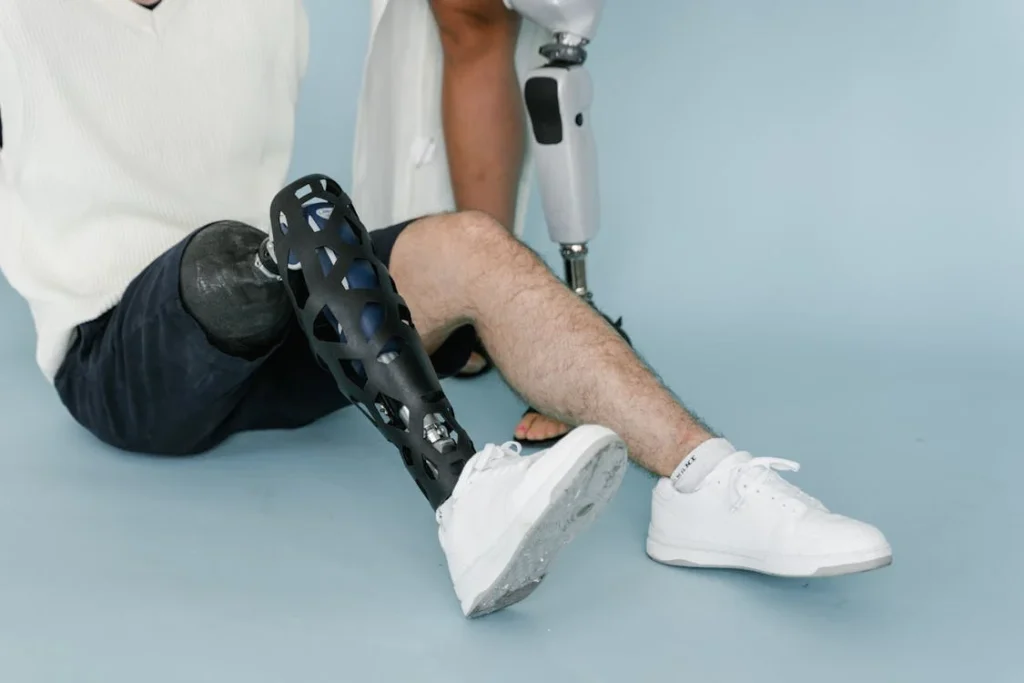
The Role of Gamified Rehabilitation in Managing Swelling and Pain
Understanding Gamified Rehabilitation
Rehabilitation after an amputation can be challenging, but integrating gamified approaches into your recovery plan can provide significant benefits.
Gamified rehabilitation refers to the use of interactive and engaging techniques, often leveraging technology, to make physical therapy more enjoyable and effective.
This innovative approach encourages active participation, which is crucial for improving circulation, reducing swelling, and managing pain.
Gamified exercises are designed to be both therapeutic and fun, using elements like virtual reality, augmented reality, or even simple interactive games.
These activities not only help patients remain motivated but also address critical aspects of recovery, such as strengthening the residual limb, enhancing mobility, and reducing discomfort.
How Gamified Rehabilitation Reduces Swelling
Swelling, or edema, is a common concern during the recovery process. The buildup of fluid in the residual limb can feel restrictive and uncomfortable, often interfering with the fitting of prosthetic devices.
Gamified rehabilitation addresses this issue by encouraging gentle, controlled movements that stimulate blood flow and prevent fluid from pooling.
Interactive games that require light limb movements, such as reaching, grasping, or rotating, are particularly effective. These activities mimic natural motions and help maintain the shape of the residual limb, preparing it for prosthetic use.
Regular participation in these exercises also ensures that the residual limb adapts to the new demands placed on it, minimizing complications related to swelling.
In addition, gamified rehabilitation encourages consistent engagement, which is vital for long-term results. Patients who are actively involved in their therapy sessions tend to experience more noticeable improvements in swelling management and overall recovery.
The visual and auditory feedback provided by gamified systems creates a sense of achievement, making it easier to stay committed to the routine.
Managing Pain Through Gamified Rehabilitation
Pain management is another area where gamified rehabilitation proves invaluable. Pain during amputation recovery can arise from multiple sources, including the residual limb, phantom limb sensations, and post-surgical nerve activity.
Gamified approaches help address these challenges by engaging the brain and body in a way that distracts from discomfort and promotes healing.
Virtual reality environments are particularly useful for managing phantom limb pain.
By creating immersive experiences that simulate the presence of the missing limb, VR-based exercises can help the brain recalibrate its response to nerve signals, reducing the intensity of phantom sensations.
Similarly, mirror therapy games use reflection to “trick” the brain into perceiving movement in the missing limb, often providing significant relief.
For residual limb pain, gamified rehabilitation focuses on controlled exercises that desensitize the area and improve circulation.
Activities that involve repetitive yet gentle movements help reduce nerve sensitivity and prevent scar tissue buildup. The structured feedback provided by gamified systems ensures that exercises are performed correctly, maximizing their effectiveness.
Emotional Benefits of Gamified Rehabilitation
Recovery after an amputation involves not just physical adjustments but emotional resilience as well. Pain and swelling can take a toll on your mental health, leading to feelings of frustration or discouragement.
Gamified rehabilitation helps address these emotional challenges by making the recovery process more engaging and rewarding.
Interactive games provide a sense of accomplishment, even for small milestones, fostering a positive mindset. They also encourage social interaction, as many systems allow users to connect with others undergoing similar rehabilitation.
Sharing progress and challenges in a supportive environment can significantly boost morale and motivation.
By combining physical therapy with elements of play, gamified rehabilitation transforms the recovery process into a more uplifting and manageable experience.
This approach empowers patients to take control of their healing journey, helping them stay focused and optimistic despite the hurdles they face.
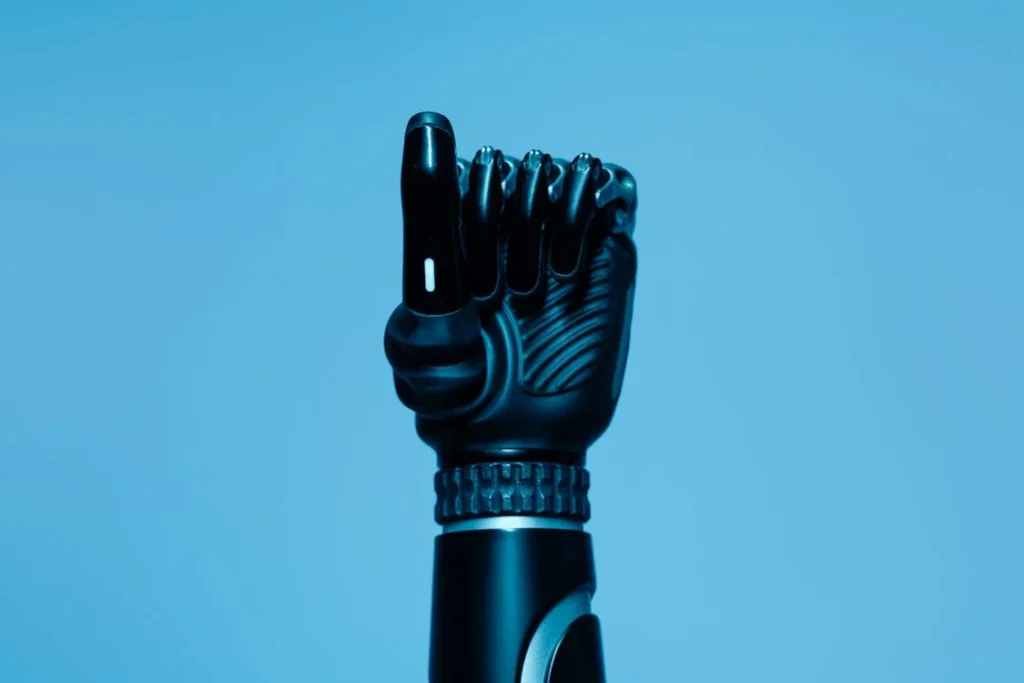
Conclusion
Managing swelling and pain during amputation recovery is essential for physical healing, emotional well-being, and successful rehabilitation. These challenges are a natural part of the recovery journey, but with the right strategies, they can be effectively addressed. From compression therapy and physical exercises to emotional support and medical guidance, a comprehensive approach ensures that you can heal comfortably and confidently.
At Robobionics, we understand the complexities of amputation recovery and are dedicated to supporting individuals every step of the way. Our advanced prosthetics, like Grippy™, and our focus on personalized care aim to empower you to regain independence and thrive in your new chapter of life.
Recovery is a journey, and with patience, resilience, and the right support, you can navigate this path successfully. For expert advice and innovative prosthetic solutions, contact us today and take the next step toward a confident and fulfilling future.



